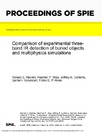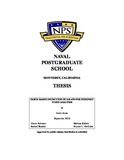Evaluation of object detection algorithms for ship detection in the visible spectrum
| dc.contributor.advisor | Fouts, Douglas | |
| dc.contributor.advisor | Kolsch, Mathias | |
| dc.contributor.author | Camp, David M. | |
| dc.date | Dec-13 | |
| dc.date.accessioned | 2014-02-18T23:38:40Z | |
| dc.date.available | 2014-02-18T23:38:40Z | |
| dc.date.issued | 2013-12 | |
| dc.identifier.uri | https://hdl.handle.net/10945/38891 | |
| dc.description.abstract | The research described here examined computer vision algorithms for suitability to aid or replace the current methods of ship detection and tracking from a photonics mast. Evaluation was conducted on three object detection methods: a bag of words (BOW) robust multi-class classification method; a histogram of oriented gradient (HOG) method, originally used for pedestrian tracking; and a deformable parts model (DPM) that was originally designed for pose recognition that has been successful in multi-class classification. A fourth method that combines the HOG and BOW was created and successfully reduced false positive detections while maintaining a high recall rate. The object detection methods were evaluated through a search theory model to frame evaluation for operational ship detection. Each object detection method was optimized following a design of experiments approach utilizing a cluster computer. The BOW method had the highest recall for ships 25 pixels and smaller, while the HOG method was the fastest of all methods when implemented on a graphical processing unit. The DPM method had the highest average recall for ships greater than 25 pixels but the lowest recall for smaller ships. Finally, the hybrid HOG and BOW method had the highest mean recall and lowest mean false positive rate over all ship sizes. | en_US |
| dc.description.uri | http://archive.org/details/evaluationofobje1094538891 | |
| dc.publisher | Monterey, California: Naval Postgraduate School | en_US |
| dc.rights | This publication is a work of the U.S. Government as defined in Title 17, United States Code, Section 101. Copyright protection is not available for this work in the United States. | en_US |
| dc.title | Evaluation of object detection algorithms for ship detection in the visible spectrum | en_US |
| dc.type | Thesis | en_US |
| dc.contributor.department | Electrical And Computer Engineering | |
| dc.subject.author | Ship detection | en_US |
| dc.subject.author | search theory | en_US |
| dc.subject.author | computer vision | en_US |
| dc.subject.author | cluster computer | en_US |
| dc.subject.author | graphical processor unit (GPU) | en_US |
| dc.subject.author | parallel computing | en_US |
| dc.subject.author | design of experiments | en_US |
| dc.subject.author | object detection | en_US |
| dc.description.recognition | Outstanding Thesis | en_US |
| dc.description.service | Lieutenant, United States Navy | en_US |
| etd.thesisdegree.name | Master Of Science In Electrical Engineering | en_US |
| etd.thesisdegree.level | Masters | en_US |
| etd.thesisdegree.discipline | Electrical Engineering | en_US |
| etd.thesisdegree.grantor | Naval Postgraduate School | en_US |
| dc.description.distributionstatement | Approved for public release; distribution is unlimited. |
Files in this item
This item appears in the following Collection(s)
-
1. Thesis and Dissertation Collection, all items
Publicly releasable NPS Theses, Dissertations, MBA Professional Reports, Joint Applied Projects, Systems Engineering Project Reports and other NPS degree-earning written works. -
2. NPS Outstanding Theses and Dissertations





